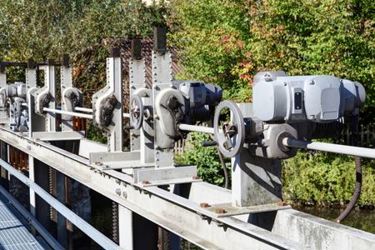Technological Services In Wastewater Remote Monitoring And Management
By Daniel Theobald, "Wastewater Dan"

Recent improvements in remote monitoring and management technologies, particularly in the wastewater treatment sector, have revolutionized operational efficiency. Key technologies include IoT sensors, AI analytics, and cloud computing.
This article explores their applications and benefits in enhancing wastewater treatment processes.
IoT Sensors In Wastewater Treatment
IoT sensors enhance efficiency, compliance, and sustainability in wastewater treatment, enabling facilities to optimize operations and reduce environmental impacts.
Real-time monitoring of wastewater treatment quantity/quality
IoT sensors in wastewater treatment are devices equipped with Internet of Things (IoT) technology that monitor and manage various parameters in wastewater systems. IoT sensors are pivotal in wastewater treatment, providing essential data for effective management. These sensors continuously monitor parameters such as pH levels, temperature, turbidity, dissolved oxygen, and flow rates.
Benefits:
Real-time monitoring – Continuous data collection allows operators to understand the immediate state of wastewater treatment processes.
Data collection and transmission – Data is sent to cloud-based platforms, enabling centralized management and analysis.
Automation and control – Sensors can trigger automatic adjustments in treatment processes based on real-time data. For example, when a pH imbalance is detected, the system can adjust chemical dosing automatically.
Predictive maintenance – By monitoring equipment performance, IoT sensors can predict failures, thus minimizing downtime and costs.
Compliance and reporting – Accurate data from sensors ensures compliance with environmental regulations, simplifying reporting to authorities.
Data analytics – Collected data can be analyzed to optimize processes and improve resource management.
Functioning of IoT sensors
Sensing technologies – Sensors employ electrochemical, optical, or ultrasonic technologies to measure specific wastewater parameters.
Connectivity – The sensors use wireless communication protocols (such as Wi-Fi, or cellular networks) to transmit data to a central system or cloud storage.
Data processing – Once the data is received, it can be processed using software that analyzes the information, generates alerts, and provides insights into system performance.
User interface – Operators typically access the data through user-friendly instrument boards that visualize key metrics, trends, and alerts, allowing for informed decision-making.
Feedback loop – The system can create a feedback loop, where the data collected informs adjustments in the treatment process, which are then monitored by the sensors to ensure optimal performance.
AI Analytics For Predictive Diagnostics
AI analytics refers to the use of artificial intelligence techniques to analyze data and extract insights. AI analytics plays a significant role in improving operational efficiency through predictive know-how and machine learning algorithms to analyze historical data to forecast operational requirements.
Another key function is predictive analytics, which uses AI models that can analyze historical data to predict future trends. For instance, wastewater treatment can use predictive analytics to forecast chemical use needs based on recent historical activity.
Benefits:
Equipment longevity – AI helps predict when maintenance or replacements are necessary, extending equipment lifespan.
Cost savings – By reducing unplanned downtime and maintenance costs, facilities can operate more efficiently.
Real-time analytics – AI enables quick decision-making based on current data.
Cloud Computing For Data Management
Centralized data storage and access
Cloud computing significantly enhances data management in wastewater treatment.
Applications:
1. Continuous Monitoring and Data Collection
Example: A municipal or industrial wastewater treatment operation utilizes remote sensors to continuously monitor parameters such as pH, turbidity, and dissolved oxygen (DO). These sensors transmit data in real-time to a central system.
Regulatory compliance – By continuously tracking these parameters, the facility ensures it meets local and federal discharge standards, set by the appropriate control authority such as federal, state or sewer.
Reporting – Automated reports can be generated according to required frequency, summarizing compliance data, which can be submitted to regulatory agencies with minimal manual intervention.
2. Remote Access to Historical Data
Example: Municipal and industrial facilities can use a remote wastewater data tracking system that archives historical information on treatment performance and effluent quantity/quality for regulatory compliance and reporting.
Regulatory compliance – The historical data helps the facility demonstrate compliance with discharge permits over time and track improvements or issues in treatment processes.
Reporting – When preparing for regulatory audits/inspections, the authorized professional can quickly access and present historical compliance records, making it efficient to satisfy regulatory requirements.
Monitoring data such as pH levels and turbidity and more use these platforms.
3. Automated Alerts and Notifications
Example: An industrial manufacturing plant incorporates a remote monitoring system that sends alerts when wastewater treatment results are outside predefined operating parameters.
Regulatory compliance – Immediate notification allows the facility to take corrective action before non-compliance occurs, such as revising treatment processes or temporarily halting discharge.
Reporting – Circumstantial reports can be generated automatically, providing documentation of the circumstance and actions taken, which is essential for regulatory reporting.
4. Remote Control and Management
Example: An industrial manufacturing plant uses a remote oversight system for its wastewater treatment equipment, allowing operators to adjust operational set points including chemical dosing and aeration levels from a centralized metrics visualization.
Regulatory compliance – By optimizing treatment processes remotely, the facility can maintain compliance with effluent quantity/quality standards more definitely.
Reporting – The system documents all adjustments made, creating a detailed operational report that can be submitted for regulatory review.
5. Integration with Environmental Management Systems (EMS)
Example: A municipal wastewater treatment facility integrates its remote monitoring system with an EMS platform.
Regulatory compliance – This integration allows for streamlined tracking of compliance metrics and simplifies the management of environmental data.
Reporting – The EMS can automatically compile compliance reports based on real-time data, ensuring timely submission to regulatory control authorities.
6. Remote Video Surveillance
Example: An industrial facility employs remote video surveillance to monitor wastewater treatment processes and ensure proper operation.
Regulatory compliance – Video feeds can help verify that processes are being followed correctly, which is crucial for compliance with operational standards.
Reporting – In the event of a circumstance, video footage can be included in investigation reports, demonstrating adherence to protocols or identifying areas for improvement.
7. Predictive Analytics for Maintenance
Example: A wastewater treatment plant implements predictive analytics on operational data collected remotely to forecast equipment failures.
Regulatory compliance – By preventing equipment breakdowns, the facility can avoid compliance violations related to equipment malfunctions that could impact effluent quantity/quality.
Reporting – Maintenance records generated from predictive analytics can be included in compliance reports, showing proactive management of treatment infrastructure.
These examples illustrate how remote services enhance the efficiency and effectiveness of wastewater treatment operations while ensuring regulatory compliance and facilitating accurate reporting.
Conclusion
The integration of IoT sensors, AI analytics, and cloud computing in wastewater treatment enhances operational efficiency significantly. By leveraging real-time data, predictive maintenance capabilities, and centralized data management, facilities can optimize processes, ensure compliance, and improve overall service delivery. These technological improvements not only streamline operations but also contribute to more sustainable and environmentally responsible wastewater management practices.
About Dan Theobald
 Known in the industry as “Wastewater Dan,” Daniel L. Theobald, proprietor of Environmental Services (www.esdlt.com), is a professional wastewater and safety consultant/trainer. He has more than 35 years of hands-on industry experience, since 1987, operating many variants of wastewater treatment processing units and is eager to share his knowledge about wastewater with others.
Known in the industry as “Wastewater Dan,” Daniel L. Theobald, proprietor of Environmental Services (www.esdlt.com), is a professional wastewater and safety consultant/trainer. He has more than 35 years of hands-on industry experience, since 1987, operating many variants of wastewater treatment processing units and is eager to share his knowledge about wastewater with others.
Theobald serves as an active consultant for industries looking to achieve, maintain, and improve discharge permit compliant wastewater treatment at reduced overall cost. He is a Lifetime Member of the Who’s Who Registry of Professionals and holds numerous certifications from wastewater management regulatory boards and professional organizations. Theobald contributed one chapter to the Water Environment Federation’s (www.wef.org) Manual of Practice # 37 (MOP-37), a technical manual resource guide for biological nutrient removal, published in 2013.
